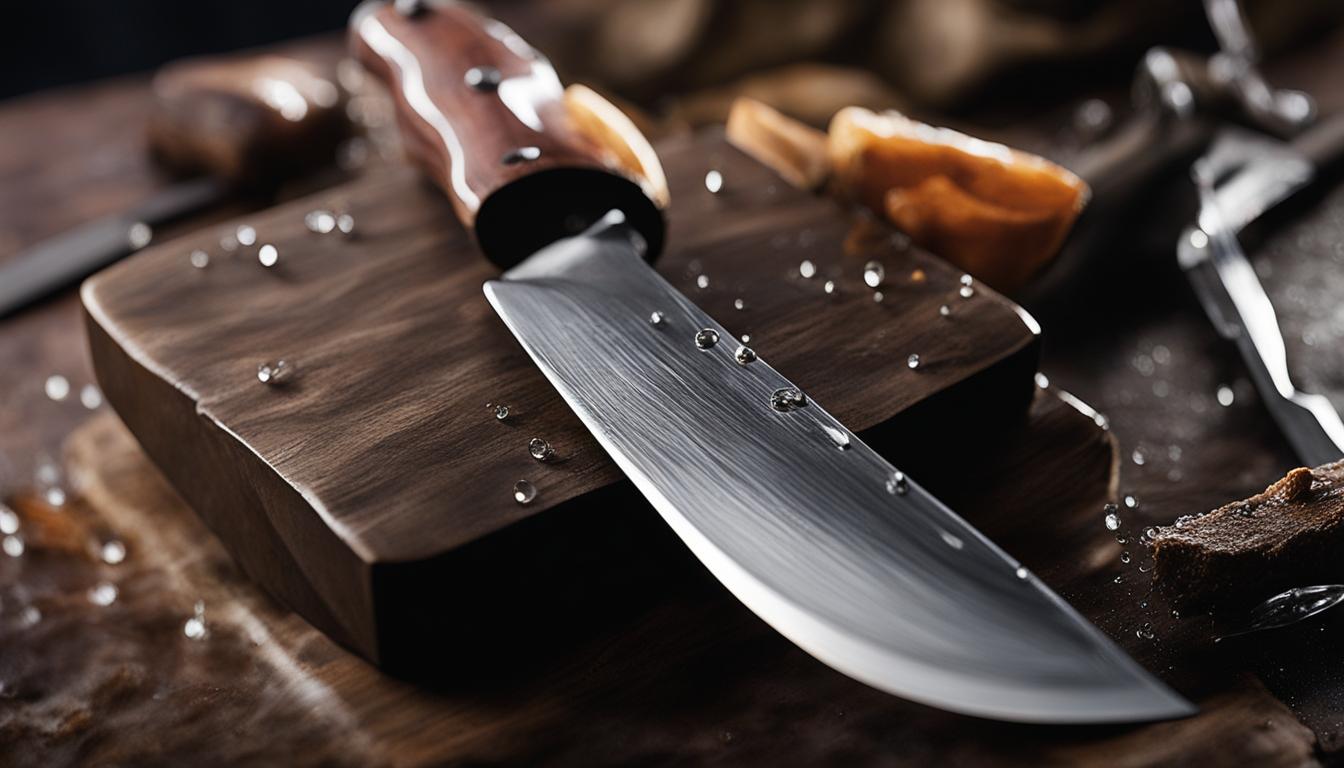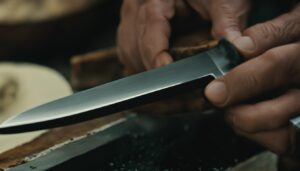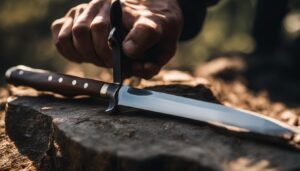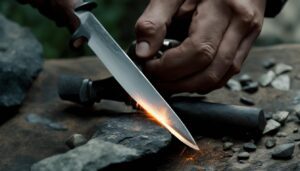Keeping your hunting knives sharp is not just a matter of convenience; it’s a matter of safety and efficiency. A sharp blade not only reduces the risk of accidents but also requires less force for cutting tasks. So, if you want to enhance the cutting power of your hunting knives, it’s time to dive into the world of sharpening stones.
Sharpening stones are the go-to tool for knife enthusiasts who value unmatched sharpness. Whether you’re a seasoned hunter or just starting out on your hunting adventures, mastering the art of using sharpening stones can make all the difference in the field.
Key Takeaways:
- Regularly sharpening your hunting knives enhances their cutting power and reduces the risk of accidents.
- Sharpening stones offer unmatched sharpness and precision.
- Different sharpening techniques can be used, such as using whetstones, manual or electric sharpeners.
- Whetstones are ideal for achieving razor-sharp edges.
- Consider your needs and preferences when choosing between manual and electric sharpeners.
The Science of Knife Sharpening
Knife sharpening is not just a simple task of honing the blade on a sharpening stone. It is a fascinating blend of art and science that involves understanding the microscopic structure of the blade and how it affects its cutting power. By delving into the science behind knife sharpening, we can achieve sharper blades and enhance our cutting experience.
When a knife is dull, its microscopic structure is compromised, leading to jagged teeth that can snag on materials instead of smoothly slicing through them. These jagged teeth are formed due to wear and tear, and the presence of burrs on the blade’s edge. Sharpening the knife helps remove these burrs and realign the blade, resulting in a smoother cutting motion and increased efficiency.
Scientific studies support the effectiveness of sharpening blades. Researchers have found that sharper blades require less force during cutting tasks compared to dull ones. This means that not only will sharpened blades make our cutting tasks easier, but they will also reduce the risk of accidents caused by applying excessive force on a dull blade. The science behind knife sharpening provides us with valuable insights into maintaining the performance of our knives.
The Microscopic Structure of Blades
The microscopic structure of blades is crucial in understanding the science of knife sharpening. When examined under a microscope, a dull blade shows irregularities and rough edges that hinder its cutting ability. By sharpening the blade, these imperfections are smoothed out, resulting in a sharper edge.
| Benefit | Description |
|---|---|
| Sharper Blades | Sharpening eliminates jagged teeth and burrs, resulting in a razor-sharp edge. |
| Efficiency | Sharper blades require less force, making cutting tasks easier and reducing the risk of accidents. |
| Scientific Studies | Research supports the idea that sharpened blades require less force during cutting tasks. |
| Microscopic Structure | A dull blade has rough edges and irregularities that hinder its cutting ability. |
Knife Sharpeners Explained
When it comes to sharpening your knives, there are various options available, each with its own advantages and considerations. Understanding the different types of knife sharpeners and their features will help you make an informed decision based on your needs. Let’s explore the two main categories of knife sharpeners: manual sharpening methods and electric sharpeners.
Manual Sharpening Methods
Manual sharpening methods, such as whetstones or honing rods, offer control and precision. Whetstones, also known as sharpening stones, come in different grit sizes, which determine the coarseness or fineness of the abrasive material used for sharpening. Coarse grit stones are typically used to set new bevels or remove nicks, while finer grit stones are used for polishing edges and achieving a razor-sharp edge.
Honing rods, on the other hand, are used to realign the blade and maintain its sharpness. They are ideal for regular maintenance and require minimal effort. Manual sharpening methods allow for adaptability and versatility, as they can be used with various knife types and sizes. They also provide a hands-on experience that some sharpening enthusiasts prefer.
Electric Sharpeners
Electric sharpeners offer convenience and speed. They are designed to automatically guide the knife through the sharpening process, making them a popular choice for those who value ease of use. Electric sharpeners often come with built-in guides to help you maintain the correct sharpening angle. They are particularly suitable for quick touch-ups and maintaining the sharpness of your blades.
When choosing a knife sharpener, consider factors such as the material type of your knives and the desired level of sharpness. Additionally, the grit size of a whetstone or the sharpening stages of an electric sharpener play a crucial role in achieving the desired results. Overall, the choice between manual and electric sharpeners depends on your personal preference, the number of knives you need to sharpen, and the level of control you want to have over the sharpening process.
Table: Comparison of Manual and Electric Knife Sharpeners
| Aspect | Manual Sharpeners | Electric Sharpeners |
|---|---|---|
| Control | High | Medium |
| Convenience | Medium | High |
| Speed | Variable | Fast |
| Sharpening Angle | Manual adjustment | Built-in guides |
| Sharpness Level | Dependent on user skill | Consistent |
| Versatility | High | Medium |
By considering these factors and understanding the differences between manual and electric sharpeners, you can choose the right tool to keep your knives sharp and ready for any cutting task.
Proficiency in Using Whetstones
Whetstones are a popular and effective tool for achieving a razor-sharp edge on your hunting knives. However, using them properly requires some proficiency and knowledge of the right techniques. In this section, I will guide you through the key aspects of using whetstones, including angle guides, sharpening angles, grit selection, and honing grades.
Angle Guides
When sharpening your hunting knives with a whetstone, it’s crucial to maintain the correct sharpening angle. The ideal angle typically ranges from 15 to 20 degrees. To ensure consistency, you can use an angle guide. This tool attaches to the blade and helps you maintain the desired angle throughout the sharpening process. It takes the guesswork out of achieving the perfect edge and ensures consistent results every time.
Grit Selection
The grit of your whetstone plays a significant role in the sharpening process. Coarse grits, typically around 200 to 400, are ideal for setting new bevels or removing nicks and chips from the blade. As you progress, you can move on to medium and fine grits, usually ranging from 800 to 3000, for sharpening and polishing the edge. The final stage involves using even finer grits, such as 5000 and above, for honing and refining the blade to achieve a mirror-like finish.
Honing Grades
Honing grades refer to the level of refinement or cutting quality that can be achieved with your whetstone. The higher the honing grade, the finer the edge you can create. For general hunting knife sharpening, a honing grade of 800 to 2000 is usually sufficient. However, if you require an exceptionally sharp edge, you can go up to 5000 or beyond. Keep in mind that achieving and maintaining an extremely high honing grade requires skill and practice.
Summary
Using whetstones requires proficiency in angle guides, sharpening angles, grit selection, and honing grades. An angle guide helps maintain the correct sharpening angle, while grit selection determines the coarseness or fineness of the abrasive material used. Honing grades play a role in determining the cutting quality of the blade. With practice and the right techniques, you can achieve a razor-sharp edge on your hunting knives using whetstones.
The Debate Between Electric vs Manual Sharpeners
When it comes to sharpening your knives, there is an ongoing debate between electric sharpeners and manual sharpeners. Each type has its advantages and considerations, making it essential to choose the option that best suits your needs and preferences.
Electric sharpeners are known for their convenience. They are designed to make the sharpening process quick and effortless. With just a push of a button, you can restore the sharpness of your blades in no time. Electric sharpeners often come with built-in guides that help maintain the correct sharpening angle, ensuring consistent results with minimal effort.
On the other hand, manual sharpeners offer more control and versatility. With a manual sharpener, you have the freedom to choose the sharpening technique that works best for you. Whether it’s using a whetstone, honing rod, or other manual sharpening tools, you can tailor the sharpening process to suit your individual preferences. Manual sharpeners also allow for more adaptability, making them suitable for a wide range of knife styles and sizes.
“Electric sharpeners are convenient and require minimal effort, while manual sharpeners offer more control and versatility.”
When deciding between electric and manual sharpeners, durability and maintenance are important factors to consider. Electric sharpeners often have more moving parts and rely on motors, which may make them more prone to wear and tear over time. Manual sharpeners, on the other hand, are typically more durable and require minimal maintenance.
| Electric Sharpeners | Manual Sharpeners | |
|---|---|---|
| Convenience | ✔️ | ❌ |
| Control | ❌ | ✔️ |
| Durability | ❌ | ✔️ |
| Maintenance | ❌ | ✔️ |
In conclusion, the choice between electric and manual sharpeners depends on your personal preferences and needs. If you value convenience and efficiency, an electric sharpener may be the right option for you. However, if you prioritize control, versatility, and durability, a manual sharpener would be a better fit. Ultimately, the most important factor is to ensure that your knives are regularly sharpened to maintain their cutting power and extend their lifespan.
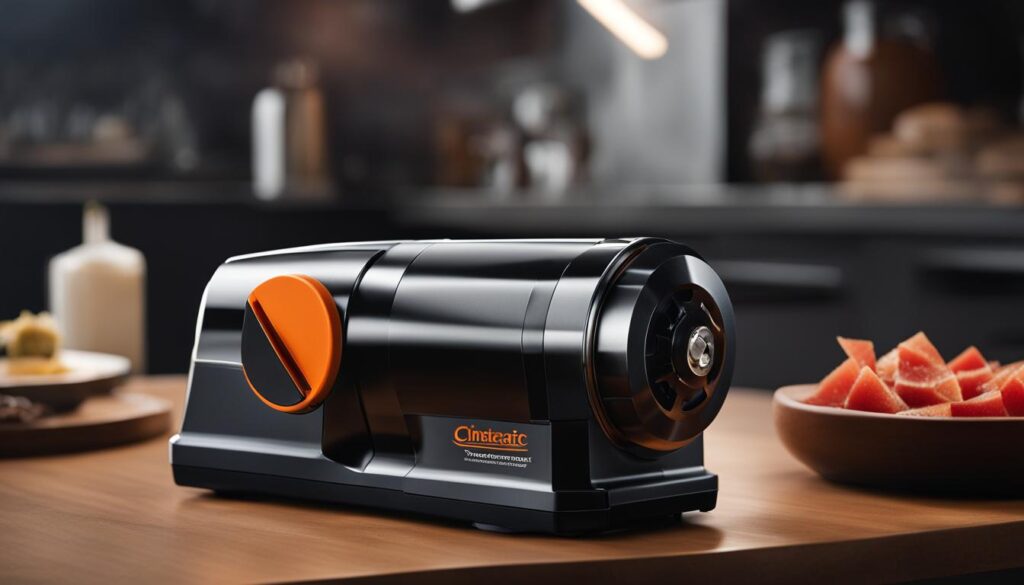
Advanced Knife Sharpening Techniques
When it comes to sharpening knives, there are several advanced techniques that can be used to achieve optimal results. These techniques involve the use of specific tools such as grinding wheels, bench grinders, honing steels, and sharpening stones. Each technique is suited for different types of tools and offers its own advantages in terms of precision, speed, and material removal.
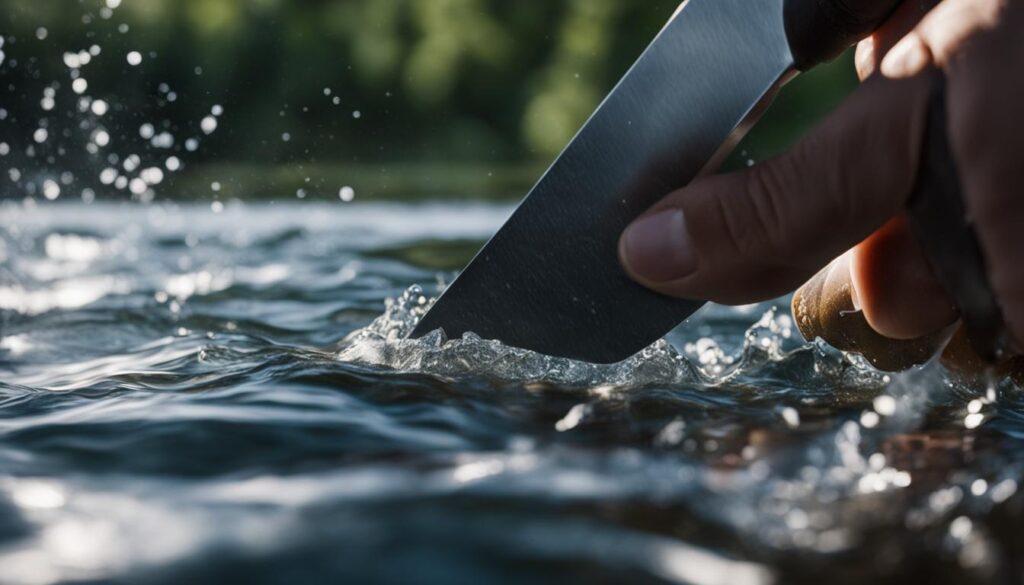

One popular advanced technique is using a grinding wheel on a bench grinder. This method is ideal for quickly removing material from the blade and shaping the edge. However, caution must be taken to prevent overheating the blade, as excessive heat can damage the tempering of the steel.
Honing steels are another valuable tool for advanced knife sharpening. These tools are mainly used for regular maintenance and realigning the blade’s edge. By running the knife’s edge along the honing steel at the correct angle, you can remove any remaining burrs and achieve a razor-sharp edge.
Sharpening stones, such as whetstones, are highly versatile and allow for precise sharpening and polishing. These stones come in various grit sizes, each suited for different stages of the sharpening process. Coarser grits are used to set new bevels or remove nicks, while finer grits are employed for refining the edge and achieving a polished finish.
Conclusion
In conclusion, the importance of knife sharpening cannot be overstated. Not only does it enhance the cutting power of your blades, but it also plays a crucial role in ensuring efficiency and safety. Sharp blades reduce the risk of accidents and require less force for cutting tasks, making them a valuable tool in any kitchen or outdoor adventure.
When it comes to maintaining sharp blades, choosing the right sharpening method is key. Manual methods like whetstones offer control and precision, allowing you to achieve unmatched sharpness. On the other hand, electric sharpeners provide convenience and speed, making them perfect for quick touch-ups.
Whether you prefer the artistry of manual sharpening or the efficiency of electric sharpeners, regular maintenance and proper care of your sharpening tools are essential. By investing time and effort into sharpening your knives, you ensure that they remain in top shape, ready to tackle any cutting task that comes your way.
FAQ
Why is it important to keep knives sharp?
Keeping knives sharp is important for efficiency and safety. Sharp blades reduce the risk of accidents and require less force for cutting tasks.
What are the different sharpening techniques for knives?
Different sharpening techniques can be used, such as using whetstones, manual or electric sharpeners. Whetstones offer unmatched sharpness, while electric or manual options are great for quick touch-ups.
How does sharpening a knife improve its performance?
When viewed under a microscope, a dull knife has jagged teeth that can snag on materials. Sharpening the knife eliminates these burrs, resulting in less resistance during cutting tasks. Scientific studies support the idea that sharper blades require less force.
What are the different types of knife sharpeners?
There are different types of knife sharpeners, including manual sharpening methods like whetstones or honing rods, and electric sharpeners. Manual sharpeners offer control and range from pocket-sized gadgets to larger bench stones. Electric sharpeners are convenient and do most of the work for you.
How do whetstones work and what should I consider when using them?
Whetstones are a popular choice for achieving a razor-sharp edge. Using an angle guide helps maintain the correct sharpening angle, typically 15-20 degrees. Grit selection is important for achieving the desired sharpness. Coarse grits are ideal for setting new bevels or removing nicks, while finer grits are used for polishing edges. Honing grades also play a role in determining the cutting quality of the blade.
Which is better, electric or manual sharpeners?
There is a debate between electric and manual sharpeners. Electric sharpeners are convenient and require minimal effort, while manual sharpeners offer more control and versatility. Electric sharpeners often have built-in guides for maintaining the correct angle. Manual sharpeners allow for more adaptability and precision. Consider durability and maintenance when choosing between the two options.
Are there any advanced knife sharpening techniques?
Advanced knife sharpening techniques include using a grinding wheel on a bench grinder, using a honing steel, and using a sharpening stone. Each technique is suited for different tools and has its advantages. Grinding wheels are powerful and can quickly remove material, but caution must be taken to prevent overheating the blade. Honing steels are used to realign the blade and are ideal for regular maintenance. Sharpening stones, like whetstones, allow for precise sharpening and polishing.
Why is knife sharpening important?
Sharpening knives is important for efficiency, safety, and maintaining the cutting power of the blades. Choosing the right sharpening method depends on individual needs and preferences. Manual methods like whetstones offer control and precision, while electric sharpeners provide convenience and speed. Regular maintenance and proper care of sharpening tools are key to keeping knives in top shape.
